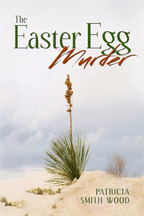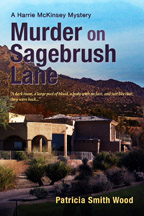Author Patricia Smith Wood credits her father, a career FBI agent, for sparking her interest in law enforcement and solving crimes. After retiring from a business career that included working at the FBI and owning her own computer company, Pat published her first of the Harrie McKinsey Mysteries in 2013. Murder at the Petroglyphs (Aakenbaaken & Kent, 2019) is the fourth book in the series that once again follows editor and amateur sleuth Harrie and her business partner Ginger as they attempt to solve a complicated murder. You’ll find Pat on her website at PatriciaSmithWood.com and on Facebook and Twitter. For more information about previous books in her series, read her 2015 and 2017 SWW interviews.
 What is your elevator pitch for Murder at the Petroglyphs?
What is your elevator pitch for Murder at the Petroglyphs?
Are the Ancient Ones responsible for the body discovered at Petroglyphs National Monument? Why did Harrie McKinsey have a prophetic dream about it? Why haven’t the media in Albuquerque reported on this unexplained death? And why can’t the Albuquerque Police, the FBI, or the CIA discover the identity of the victim?
What unique challenges did this work pose for you?
I found myself doing a lot more research on this book than on the other three. Even though I’ve lived in Albuquerque since 1951, I had never visited the Petroglyphs until I decided to set the mystery there. Also, I’m not what you would call an “outdoor girl” type. I’ve routinely taken walks around my neighborhood, but hikes in the desert or mountains are not my bag. So I had to find a twist to anchor the story and justify using the Petroglyphs.
Tell us how the book came together.
It was actually my husband who suggested the Petroglyphs as a setting. I had just come out of the swirl of activity connected with the release of my third book, Murder on Frequency. I always think I can sit back and relax once a book is finally out there. But I immediately started being questioned about the next book and when it would be published. In the past, I had an idea at least. Not this time. So when my husband suggested it, I told him I knew nothing about the Petroglyphs. That’s when he picked up the car keys and said, “Let’s go take a look.” We spent most of our time at the Visitor Center and at the Amphitheater. I took many photos so I could have a picture in my mind while writing the book. It was also in a location relatively close to the George Maloof Air Park where model airplane and drone hobbyists gather to fly their machines. Since I wanted to include drones in the story (to satisfy some of my Ham radio buddies), that worked in very well.
It took me a little over two years to write. Then, of course, came the editing. That took about four months. In the middle of that two-year period, my 98-year-old mother passed away. We had all sorts of details to take care of and deal with her property and possessions. So that made it more difficult to focus on the book. The editing process is really the best part. You’ve finished the book—now you can “pretty it up” and make it shine (with any kind of luck at all!)
 Who are the main characters in the Harrie McKinsey Mystery series, and why will readers connect with them?
Who are the main characters in the Harrie McKinsey Mystery series, and why will readers connect with them?
Since the first book, The Easter Egg Murder, I’ve had the same six characters in the series. In the second book I introduced a new female police detective sergeant and I’ve kept her in every book since then. The main characters are Harrie McKinsey and Ginger Vaughn. There’s DJ Scott (an FBI agent), Steve Vaughn (Ginger’s husband), Caroline Johnson (DJ’s mother and Harrie and Ginger’s office manager), and homicide detective Lt. Bob Swanson (Swannie). The new “regular” added in book two is Detective Sergeant Cabrini Paiz. In book number three I introduce her husband and son.
I hope readers see Harrie and Ginger (who are somewhere in their late thirties or early forties as the books proceed) as women they might know and want to hang out with. I hope male readers can identify with the men I feature. DJ and Swannie are featured the most, and I really like them.
Is there a scene in the book you’d love to watch play out in the movie?
Actually there’s more than one, but I guess I’d pick the first chapter. It would have the most visual splendor. When I first wrote it, I included all sorts of descriptions about the sunset over the Petroglyphs on a lovely May evening, and the rising of the full moon over the Sandia Mountains. Then the park ranger takes a short walk around the area to make sure all is well. He encounters a coyote, and then discovers the body. That chapter, and its flowery and scenic descriptions, was radically modified by the editors at the publisher. They wanted a body to appear at the end of page one. Still, as a movie, seeing it would substitute for all the words they had to cut!
If your book did become a movie, who would you like to see in the roles of the main amateur female detectives?
Sandra Bullock (with hair tinted a deep auburn) as Harrie McKinsey. For Ginger, I’d like to have Geena Davis (with black hair.)
What was your favorite part of putting this project together?
Getting to read it to my critique group. They always had positive reactions and came up with some great comments and suggestions.
 You began your fiction writing career later in life. What did your mature self bring to the writing table that your younger self never could have?
You began your fiction writing career later in life. What did your mature self bring to the writing table that your younger self never could have?
I’d have to say my mature self has a huge advantage over my younger self. I’ve lived an interesting life, with lots of interesting people, jobs, relationships and situations. I’ve experienced many ups and downs that give me perspective and appreciation I didn’t have as a young woman. I can use that stuff with my various characters. I’ve either been there, done that, or know somebody who has been there and done that.
What are the challenges of writing for the cozy mystery market?
That’s a great question but not an easy answer. First, the definition of cozy is very complicated in today’s world. Traditionally, one describes it as akin to Agatha Christie’s Miss Marple. The thread running through those stories is an amateur sleuth who solves a murder (which never happens on the page—only discovered there) and does so before the authorities can solve it. Nowadays, there are so many sub-genres of cozy it’s confusing. I heard someone recently imply an authentic cozy needs comedy, romance, and a protagonist who solves everything without the help of law enforcement. That’s not the sort of cozy mystery I write. In my mind, there’s no on-screen violence, the murder takes place off stage, there’s no foul language (there may be a “hell” or a “damn” now and then), and there are no sex scenes. I wanted my mother to be able to read my books without needing to chastise me. So one of the biggest challenges is explaining to people what a cozy mystery is—at least what MY kind of cozy is.
 KL Wagoner (writing as Cate Macabe) is the author of This New Mountain: a memoir of AJ Jackson, private investigator, repossessor, and grandmother. Kathy posts to a speculative fiction blog at klwagoner.com and writes about memoir at ThisNewMountain.com.
KL Wagoner (writing as Cate Macabe) is the author of This New Mountain: a memoir of AJ Jackson, private investigator, repossessor, and grandmother. Kathy posts to a speculative fiction blog at klwagoner.com and writes about memoir at ThisNewMountain.com.


























Leave a Reply